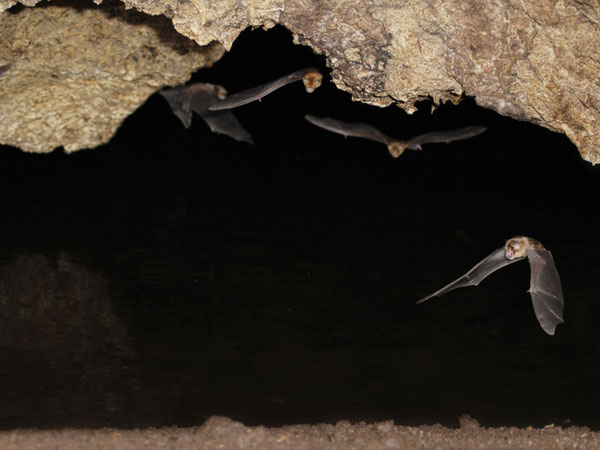Bats Think About Sex -- A Lot

Bats may have more in common with the fictional Batman than previously believed, since both successfully combine work with courting sexy potential mates -- a lot of them.
A new study, published in the latest Proceedings of the Royal Society B, reveals that bat echolocation calls, primarily used for orientation and foraging, also contain information about sex, which helps the flying mammals to acquire and keep mates.
The info is especially helpful to certain male bats with harems of adoring females that are actually huskier than the males. This holds true for the greater sac-winged bat (Saccopteryx bilineata), which was the focus of the study.
NEWS: Bats Have Fastest Mammal Muscles
Lead author Mirjam Knörnschild told Discovery News that "male S. bilineata court females whenever the opportunity arises. The social information in echolocation calls about the sex of the calling bat benefits listening harem males because they can distinguish between females and male rivals. It might also benefit calling females because they are greeted friendly."
Knörnschild, a researcher at the University of Ulm's Institute of Experimental Ecology, and her team analyzed greater sac-winged bat echolocation calls. The scientists discovered that the calls contain "pronounced vocal signatures encoding sex and individual identity." This can include species identity, age, sex, group affiliation, and other more specific information about the individual.
Previously it was thought that bats just used echolocation to see with sound, utilizing sonar to detect obstacles while in flight, to find their way around in the dark, to help forage for food, and for other essential purposes. Now it's known that this very utilitarian system serves a dual function by facilitating courtship and social communication in general.
Get the world’s most fascinating discoveries delivered straight to your inbox.
Although females of this bat species are significantly larger than males, their echolocation calls turns out to be higher pitched and shorter. When played back to males, such calls led to wooing with courtship vocalizations. When males heard the lower pitched longer echolocation calls of other males, they responded with the bat version of an aggressive rant.
Echolocation is only the latest known tool in the male bat's impressive attraction arsenal.
NEWS: Bat Uses Carnivorous Plant as a Toilet
"Male bats use various displays to attract females, often combining visual, acoustical and olfactory stimuli," Knörnschild said, explaining how males try to excite every possible sense in females.
During displays, the male will hover in front of the female and fan her vigorously, exposing her to a stinky perfume of sorts comprised of urine and glandular secretions kept in the wing sacs.
"Females generally seek physically fit or genetically compatible males as mates," she said.
She suspects that many, if not all, "bat species are capable of encoding/extracting social information in and from echolocation calls. The same is probably true for dolphins."
The study is only the latest to suggest that certain animal calls are far more complex and info-rich than previously suspected.
Researchers studying bottlenose dolphins at Sarasota Bay, Fla., for example, determined that these marine mammals create signature whistles for themselves that are comparable to human names. Project leader Laela Sayigh, now with the Woods Hole Oceanographic Institution, indicated it's possible that other information, such as the age, sex and feelings of the dolphin, may be encoded into each unique name-like whistle.
Dolphins were also recently found to hold formal greeting ceremonies at sea, possibly electing an older respected "spokesman" to handle particularly important encounters.
Greater sac-winged bats can also be compared to humans in at least one respect. In an earlier study, Knörnschild and her colleagues found that bat infants babble, mixing up echolocation with courting trills and more. Such baby babbling is the first known outside of primates.
This story was provided by Discovery News.


